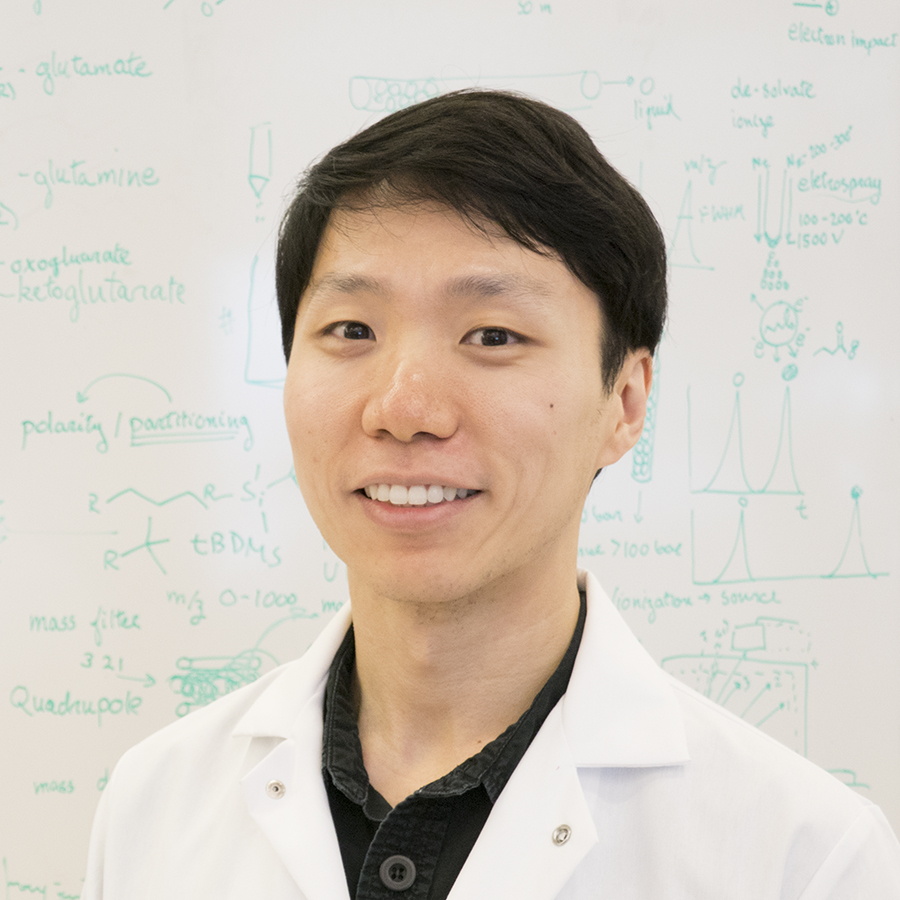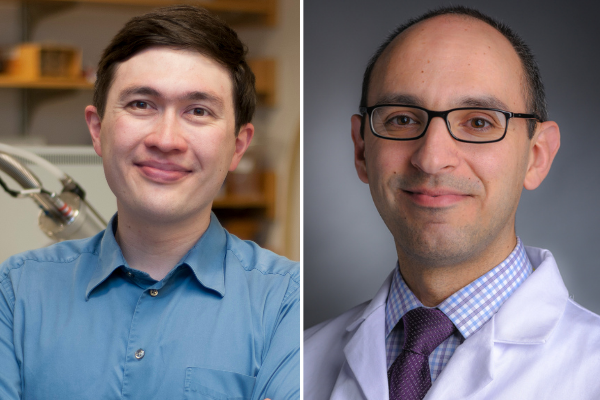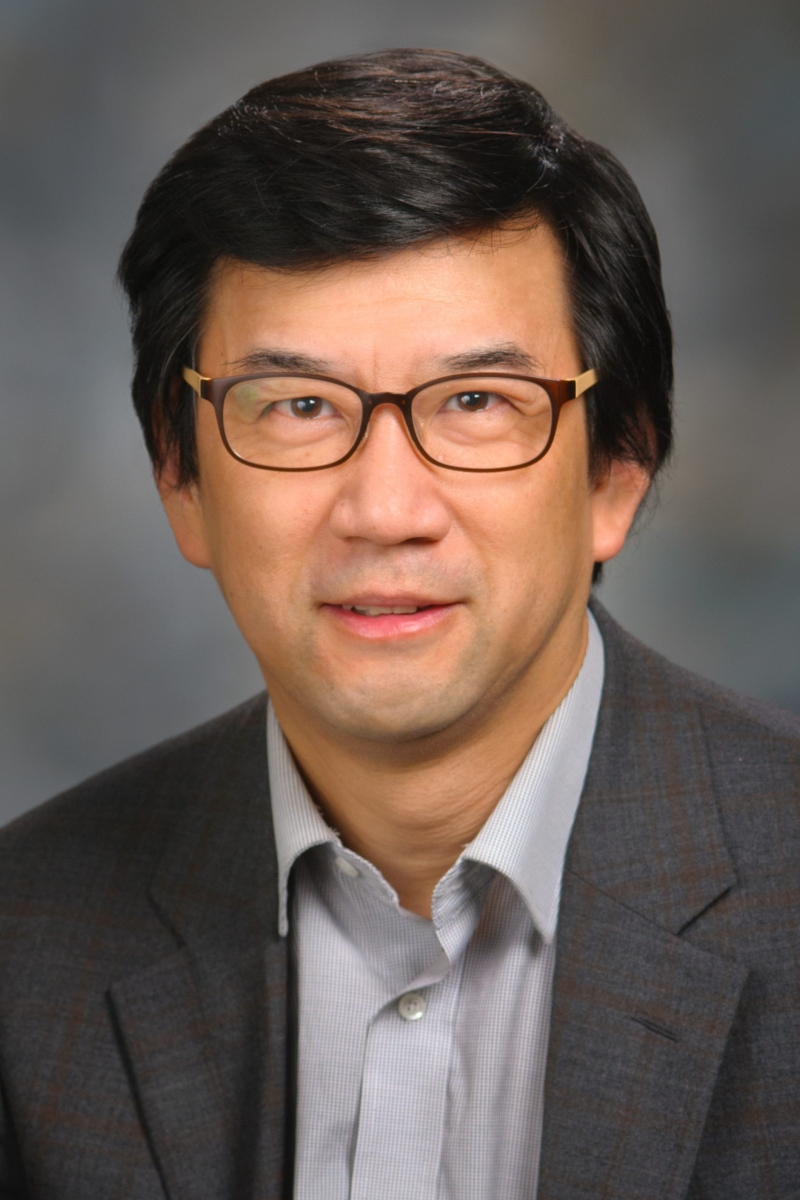New discoveries in pancreatic cancer
Pancreatic cancer is particularly difficult to diagnose since people usually have no symptoms until the cancer reaches a more advanced stage or spreads to other organs. Though progress against this cancer has been slow, Damon Runyon researchers are making an impact through understanding the biology and developing novel treatments. Recently, our scientists published results that may bring us a step closer to finding a cure.
Pancreatic cancer cells recruit “supply lines” to avoid starvation

Pancreatic cancer is difficult to treat compared to other cancers because it is made up of not only tumor cells, but also densely packed tissue called stroma. Now, current Damon Runyon researchers Robert S. Banh, PhD, and Michael E. Pacold, MD, PhD, and colleagues at the Perlmutter Cancer Center at New York University Langone Health, have discovered another unique aspect of pancreatic cancer cells—they recruit nearby nerves to grow deep into tumors and secrete nutrients for survival. The researchers also explored drugs that could cut off these supply lines and starve tumor cells. Damon Runyon-Rachleff Innovator Joseph D. Mancias, MD, PhD, of Dana-Farber Cancer Institute was also involved in this effort.
The study used cancer cells, mice, and human tissue samples to investigate pancreatic ductal adenocarcinoma (PDAC), the deadliest cancer of the pancreas. These tumors promote the growth of dense tissue that impedes blood flow, reducing the supply of oxygen and nutrients. To avoid starvation, the cancer cells secrete a protein called nerve growth factor (NGF), which signals extensions (axons) of nerve cells to grow into the tumor and deliver an amino acid called serine, a building block required for cancer cells to multiply.
Ironically, cancer cells need serine, which is already in short supply, to build NGF. To address this bottleneck, the cancer cells manipulate the protein building mechanism to minimize the production of certain proteins, so more serine is available to build stress-adaptive proteins like NGF.
Blocking the supply lines

Joseph D. Mancias, MD, PhD
When the researchers tried to deprive PDAC tumors in mice of serine by putting them on a serine-free diet, their tumors grew 50 percent more slowly. However, these serine-deprived PDAC tumors adapted by recruiting more nerves to help the tumor.
The researchers then blocked the recruitment of nerves into PDAC tumors using a drug called LOXO-101 that is used to treat other solid tumors in humans. The drug prevents NGF from interacting with nerves, effectively blocking the ability nerves to grow into tumors.
When used alone, LOXO-101 did not slow PDAC tumor growth in mice, but in combination with a serine-free diet, tumor growth slowed by an additional 50 percent, compared with the diet alone. This suggests that nerves were necessary to support PDAC cell growth in serine-deprived tumor regions.
The ability of nerves to funnel nutrients from the bloodstream to where they are needed in the pancreatic tumor microenvironment is a fascinating adaptation that suggests a potential treatment in cutting off the supply lines. Future clinical trials may be able to confirm whether this approach could decrease tumor recurrence in pancreatic cancer patients.
This work was published in Cell.
New class of immunotherapy targets found in pancreatic cancers
In a separate paper, Damon Runyon alumnus Cassian Yee, MD, and colleagues at MD Anderson Cancer Center have discovered a new target on pancreatic cells, called Vestigial-like 1 (VGLL1), which could help pancreatic cancer patients benefit from immunotherapy. These tumors have few neoantigens, or mutant proteins, which normally signal the immune system to recognize them as unhealthy cells. Pancreatic tumors also block an effective immune response by creating a dense environment that prevents blood vessels from entering.
This new class of tumor targets, called cancer-placenta antigens, is normally found only in the placenta during pregnancy, but the researchers have now found high levels in tumors in the pancreas, bladder, breast, stomach, lungs, and ovaries. Such tumor-specific targets are attractive because they allow immunotherapy to selectively find cancer cells without impacting healthy cells. In addition, increased levels of VGLL1 were associated with worse patient outcomes, which suggests that the protein enables the cancers to be more aggressive.
Developing cancer therapies targeting VGLL1

In this study, Dr. Yee and his team were able to isolate T cells that recognized VGLL1 from the blood of patients. The cells were effective at killing cultured cancer cells from a variety of cancer types. This is the first step in a new immunotherapy approach called endogenous T-cell therapy pioneered by Dr. Yee. The T cells collected from the blood of a patient that recognize specific targets on the patient’s tumor are encouraged to multiply in the laboratory and then reinfused into the patient.
“These results suggest that targeting VGLL1 is a compelling strategy for developing treatment approaches across multiple cancer types,” said Dr. Yee. “We are particularly excited to evaluate endogenous T cell therapies as an innovative option for patients without current immunotherapy options.”
Dr. Yee is leading a group of researchers in designing a clinical trial to evaluate this treatment strategy in patients whose tumors express VGLL1.
This work was published in Nature Communications.
